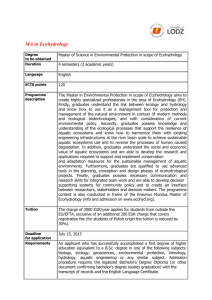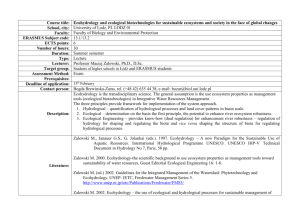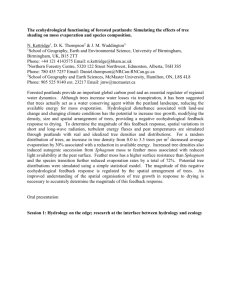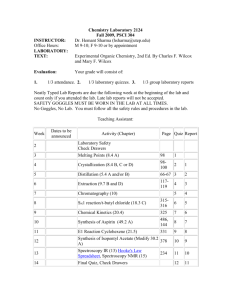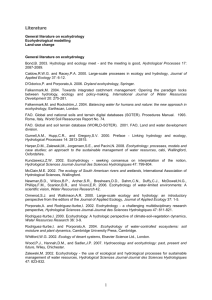Preface Ecohydrologic connections and complexities in drylands: new
advertisement
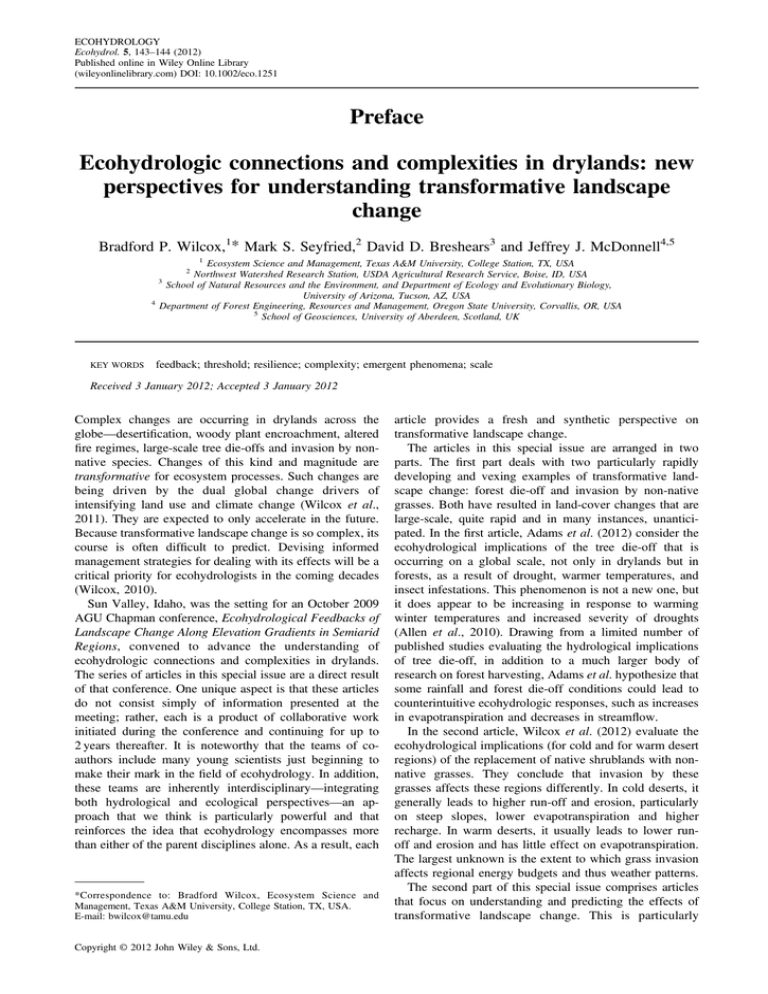
ECOHYDROLOGY Ecohydrol. 5, 143–144 (2012) Published online in Wiley Online Library (wileyonlinelibrary.com) DOI: 10.1002/eco.1251 Preface Ecohydrologic connections and complexities in drylands: new perspectives for understanding transformative landscape change Bradford P. Wilcox,1* Mark S. Seyfried,2 David D. Breshears3 and Jeffrey J. McDonnell4,5 1 Ecosystem Science and Management, Texas A&M University, College Station, TX, USA Northwest Watershed Research Station, USDA Agricultural Research Service, Boise, ID, USA 3 School of Natural Resources and the Environment, and Department of Ecology and Evolutionary Biology, University of Arizona, Tucson, AZ, USA 4 Department of Forest Engineering, Resources and Management, Oregon State University, Corvallis, OR, USA 5 School of Geosciences, University of Aberdeen, Scotland, UK 2 KEY WORDS feedback; threshold; resilience; complexity; emergent phenomena; scale Received 3 January 2012; Accepted 3 January 2012 Complex changes are occurring in drylands across the globe—desertification, woody plant encroachment, altered fire regimes, large-scale tree die-offs and invasion by nonnative species. Changes of this kind and magnitude are transformative for ecosystem processes. Such changes are being driven by the dual global change drivers of intensifying land use and climate change (Wilcox et al., 2011). They are expected to only accelerate in the future. Because transformative landscape change is so complex, its course is often difficult to predict. Devising informed management strategies for dealing with its effects will be a critical priority for ecohydrologists in the coming decades (Wilcox, 2010). Sun Valley, Idaho, was the setting for an October 2009 AGU Chapman conference, Ecohydrological Feedbacks of Landscape Change Along Elevation Gradients in Semiarid Regions, convened to advance the understanding of ecohydrologic connections and complexities in drylands. The series of articles in this special issue are a direct result of that conference. One unique aspect is that these articles do not consist simply of information presented at the meeting; rather, each is a product of collaborative work initiated during the conference and continuing for up to 2 years thereafter. It is noteworthy that the teams of coauthors include many young scientists just beginning to make their mark in the field of ecohydrology. In addition, these teams are inherently interdisciplinary—integrating both hydrological and ecological perspectives—an approach that we think is particularly powerful and that reinforces the idea that ecohydrology encompasses more than either of the parent disciplines alone. As a result, each *Correspondence to: Bradford Wilcox, Ecosystem Science and Management, Texas A&M University, College Station, TX, USA. E-mail: bwilcox@tamu.edu Copyright © 2012 John Wiley & Sons, Ltd. article provides a fresh and synthetic perspective on transformative landscape change. The articles in this special issue are arranged in two parts. The first part deals with two particularly rapidly developing and vexing examples of transformative landscape change: forest die-off and invasion by non-native grasses. Both have resulted in land-cover changes that are large-scale, quite rapid and in many instances, unanticipated. In the first article, Adams et al. (2012) consider the ecohydrological implications of the tree die-off that is occurring on a global scale, not only in drylands but in forests, as a result of drought, warmer temperatures, and insect infestations. This phenomenon is not a new one, but it does appear to be increasing in response to warming winter temperatures and increased severity of droughts (Allen et al., 2010). Drawing from a limited number of published studies evaluating the hydrological implications of tree die-off, in addition to a much larger body of research on forest harvesting, Adams et al. hypothesize that some rainfall and forest die-off conditions could lead to counterintuitive ecohydrologic responses, such as increases in evapotranspiration and decreases in streamflow. In the second article, Wilcox et al. (2012) evaluate the ecohydrological implications (for cold and for warm desert regions) of the replacement of native shrublands with nonnative grasses. They conclude that invasion by these grasses affects these regions differently. In cold deserts, it generally leads to higher run-off and erosion, particularly on steep slopes, lower evapotranspiration and higher recharge. In warm deserts, it usually leads to lower runoff and erosion and has little effect on evapotranspiration. The largest unknown is the extent to which grass invasion affects regional energy budgets and thus weather patterns. The second part of this special issue comprises articles that focus on understanding and predicting the effects of transformative landscape change. This is particularly 144 B. WILCOX ET AL. challenging because feedbacks and interactions between the drivers of change and the responses to change are exceedingly complex, involving nonlinear behaviour, threshold responses, intertwined feedbacks and ecohydrological connectivity. Turnbull et al. (2012) argue that ecosystem state change is, in many respects, determined by the nature of ecohydrological feedbacks brought about by disturbances. Specifically, they contend that a state change occurs when exogenous forces weaken stabilizing feedbacks and that such a state change can be reversed only if amplifying feedbacks do not develop. Jenerette et al. (2012) argue that a deeper understanding of water-limited ecohydrological systems will only be achieved by understanding them as complex adaptive systems that are capable of self-organization across multiple scales. Using ideas from complexity science, they synthesize and reconcile alternative views of complexity from the ecology and hydrology communities. Miller et al. (2012) suggest that a better understanding of ecohydrological connectivity may be a key to understanding and predicting how landscapes respond to environmental change. They describe connectivity broadly as a system-level network of transport vectors that link the resources and/or organisms characterizing a ‘patch’ or unit of the system. Ecohydrological connectivity, then, relates to water transport through and ecosystems, including atmospheric links via ‘recycled’ water. They use system dynamics modelling to explore how connectivity via water pathways may affect ecohydrologic processes in savanna landscapes. System dynamics modelling is especially promising for evaluating connectivity because it is able to eliminate the artificial separation of processes inherent in many modelling approaches and thus can simulate emergent behaviour resulting from feedbacks. Finally, Wang et al. (2012) present a new conceptual framework for scaling up quantitative models of ecohydrological and biogeochemical processes using electrical circuit analogies and Thévenin’s theorem. This new framework is illustrated with case applications quantifying water, carbon and nitrogen transport at different scales. Copyright © 2012 John Wiley & Sons, Ltd. This series of articles not only represents a testimonial to the rapid progression of ecohydrology as a field but also reinforces the potential for new insights through targeted interdisciplinary collaboration. Within this issue, readers will find new insights and hypotheses, the testing of which can serve as a roadmap for future research. As a whole, these articles highlight the need for ongoing interdisciplinary work and demonstrate that ecohydrology is well poised to advance substantially our understanding of transformative landscape change and its many implications. REFERENCES Adams HD, Luce CH, Breshears DD, Allen CD, Weiler M, Hale CV, Smith AMS, Huxman TE. 2012. Ecohydrological consequences of drought-and infestation-triggered tree die-off: insights and hypotheses. Ecohydrology. 5: 145–159. DOI: 10.1002/eco.233 Allen CD, Macalady AK, Chenchouni H, Bachelet D, McDowell N, Vennetier M, Kitzberger T, Rigling A, Breshears DD, Hogg EH, Gonzalez P, Fensham R, Zhang Z, Castro J, Demidova N, Lim JH, Allard G, Running SW, Semerci A, Cobb N. 2010. A global overview of drought and heat-induced tree mortality reveals emerging climate change risks for forests. Forest Ecology and Management 259: 660–684. Jenerette GD, Barron-Gafford GA, Guswa AJ, McDonnell JJ, Villegas JC. 2012. Organization of complexity in water limited ecohydrology. Ecohydrology. 5: 184–199. DOI: 10.1002/eco.217 Miller GR, Cable JM, McDonald AK, Bond B, Franz TE, Wang L, Gou S, Tyler AP, Zou CB, Scott RL. 2012. Understanding ecohydrological connectivity in savannas: a systems dynamics modelling approach. Ecohydrology. 5: 200–220. DOI: 10.1002/eco.245 Turnbull L, Wilcox BP, Belnap J, Ravi S, D’Odorico P, Childers D, Gwenzi W, Okin G, Wainwright J, Caylor KK, Sankey T. 2012. Understanding the role of ecohydrological feedbacks in ecosystem state change in drylands. Ecohydrology. 5: 174–183. DOI: 10.1002/eco.265 Wang L, Zou CB, O’Donnell F, Good S, Franz TE, Miller GR, Caylor KK, Cable JM, Bond B. 2012. Characterizing ecohydrological and biogeochemical connectivity across multiple scales: a new conceptual framework. Ecohydrology. 5: 221–233. DOI: 10.1002/eco.187 Wilcox BP. 2010. Transformative ecosystem change and ecohydrology: ushering in a new era for watershed management. Ecohydrology 3: 126–130. Wilcox BP, Sorice MG, Young MH. 2011. Drylands in the Anthropocene: taking stock of human-ecological interactions. Geography Compass 5/3: 112–127. Wilcox BP, Sorice MG, Angerer J, Wright CL. 2012. Historical changes in stocking densities on Texas rangelands. Rangeland Ecology & Management submitted. Ecohydrol. 5, 143–144 (2012) DOI: 10.1002/eco
